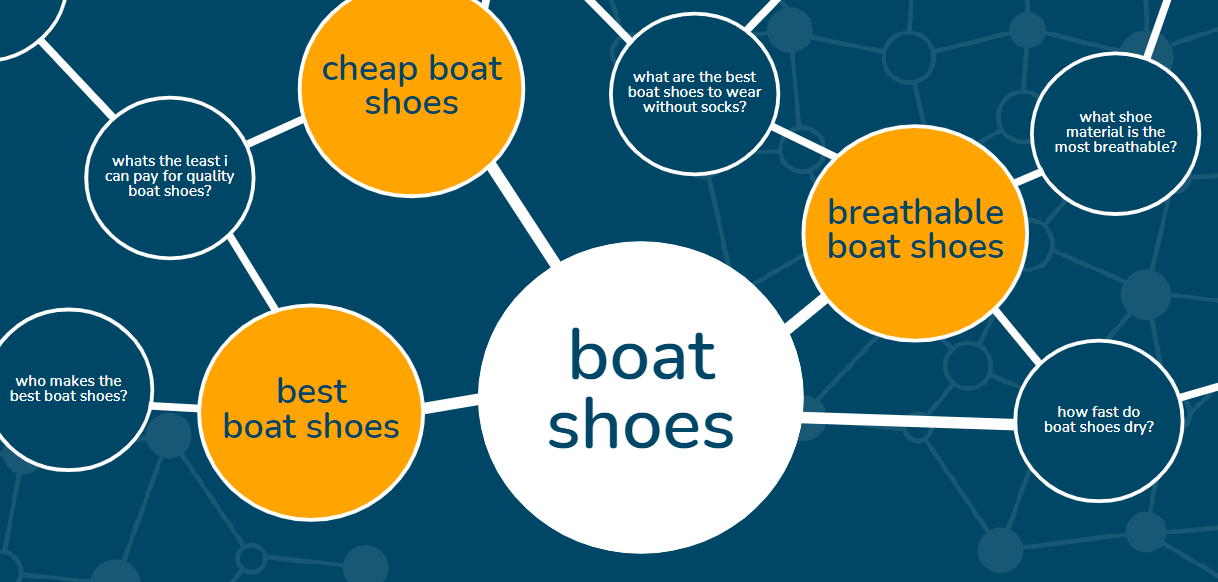Understanding the Modern Buyer’s Journey with Personalization and Entity-Based SEO

Recently, I had the exciting opportunity to attend a webinar hosted by Ryan Brock, Chief Solution Officer at DemandJump, in which he introduced a concept that caught my attention – the “Spiderweb approach to Buyer Search Behaviors.”
This interesting idea prompted me to re-evaluate how I think about content strategy in our rapidly evolving digital landscape.
The Spiderweb approach put forward by Ryan represents a significant shift in how we approach content creation and delivery. Traditionally, there was a focus on creating generalized content to reach a broad audience, as many people as possible.
This shift towards greater personalization, driven by advancements in artificial intelligence, has been nothing short of remarkable. AI has empowered the mass production of tailored content through the use of entities/topics, which AI algorithms can identify and analyze with incredible precision.
In today’s article, we will explore the latest trends in buyer search behavior and delve into the increasing complexity accompanying these changes. We will also examine how the Spiderweb approach and the shift towards content personalization, driven by advancements in AI, are reshaping the way we think about content strategy in our rapidly evolving digital landscape.
Want more marketing news? Subscribe to our free newsletter.
Challenges of the Traditional Sales Funnel
Consumer research, discovery, and decision-making have changed significantly. Traditional sales funnels, which used to depict a linear journey from awareness to conversion, no longer fully capture the complexity of the modern buyer’s path.
This is one of the fundamental issues with the sales funnel: its linear nature, assuming customers progress through stages in a predictable sequence. In reality, potential buyers often move back and forth between these stages as they conduct research and compare options. Today’s consumers engage with various touch points like social media, search engines, reviews, emails, and peer recommendations, creating a network of interactions that challenges the conventional funnel model.
The Complexity of the B2B Buyer Journey
The B2B buyer journey is even more intricate, involving multiple decision-makers and stakeholders, each with their unique goals and priorities. This complexity makes it challenging to understand and optimize the sales process, as it involves numerous touchpoints with potential buyers.
Buyers don’t fit into a single buyer’s journey. There are several avenues they could take to achieve their goal. Gartner’s depiction, as seen below, of the B2B journey highlights why the traditional sales funnel approach may not be as effective in the digital age. It assumes how someone is introduced to the company and the journey they go on to reach a purchase decision, even though people search in different ways.

The Role of Entity-Based SEO
How can marketers adapt to the evolving algorithms of search engines? The answer lies in entity-based SEO, a burgeoning field with immense potential, albeit one that is still in its early stages.
Historically, Search Engine Optimization (SEO) has primarily revolved around keywords. Marketers conducted keyword research and carefully selected and optimized keywords to improve a website’s search engine rankings. However, as Google and other search engines and their algorithms have evolved, a new emphasis on entities has emerged.
Entity-based SEO is a search engine’s attempt to show the most accurate results to users. It connects user intent and context.
Take this example: The traditional search experience involved businesses identifying keywords on each web page, essentially telling Google that when someone searches for that phrase, their page should appear in the results. However, this approach relies solely on the ethics of the business. They could very well identify a keyword irrelevant to the content on the webpage, resulting in a poor user experience because they won’t find what they’re looking for.
Entity-based SEO ensures a more positive user experience by showing more accurate search results. Search engines do this by analyzing the context of the webpage in more detail. It doesn’t solely rely on the keyword to explain what the page is about.
Search engines now understand that users don’t search for things the same way; everyone’s buyer journey is unique. That’s where the Spiderweb approach comes in. Buyers now have the flexibility to explore different paths and engage with multiple touchpoints on their way to making a purchase decision. They are no longer confined to a strict, linear funnel but instead explore routes that better suit their unique needs.
See the image below from Ryan’s presentation as an example of the Spiderweb approach to search. People searching for boat shoes have different intentions. One wants cheap boat shoes. Another wants the best boat shoes, and the other wants breathable boat shoes. They will all go on different search routes to find what they’re looking for, using questions identified in the image.

Improving Personalization with Entity-Based SEO
Let’s break down how entity-based SEO impacts the traditional sales funnel.
1. Personalized Content
Entity-based SEO introduces a fresh perspective on content strategy, emphasizing creating personalized and relevant content tailored to individual buyers’ interests. This approach brings forth several key advantages.
- Tailored Messaging: Entity-based SEO empowers marketers to identify specific entities or topics of interest within their target audience. This enables the creation of messaging that directly speaks to these interests, resulting in more engaging and relatable content.
- Content Recommendations: Marketers can offer personalized content recommendations by analyzing the entities that resonate with different audience segments. For example, if a visitor shows interest in a particular entity, the website can suggest related articles, products, or services. This enhances the user experience and increases the likelihood of conversion.
- Building Trust: Content precisely aligned with user needs and interests fosters trust. Brands that consistently provide valuable and personalized information are more likely to gain the trust of users, a critical factor in guiding users through the sales funnel.
- Engagement Throughout the Funnel: Personalized content maintains user engagement across the buyer’s journey stages. Whether users are in the awareness, consideration, or decision stage, tailored content ensures they find value at each step, ultimately increasing the likelihood of conversion.
2. Better Understanding of Buyer Behavior
Entity-based SEO provides marketers with a better understanding of how buyers interact with entities at different stages of the sales funnel. This understanding helps map buyer behavior more precisely and identify important touchpoints and opportunities.
- Entity Tracking: Marketers can closely monitor the entities users engage with during their buyer’s journey. This information reveals which topics or concepts influence the decision-making process.
Identifying Trends: By analyzing entity interaction patterns, marketers can spot trends in buyer behavior. For example, they can discover which entities consistently lead to conversions or serve as initial touchpoints in the awareness stage. - Content Optimization: With insights into how entities affect buyer behavior, marketers can refine their content strategies. They can prioritize creating and promoting content related to influential entities that guide users through the sales funnel.
- Targeted Outreach: Knowing which entities resonate with specific buyer segments enables precise outreach efforts. Marketers can create campaigns tailored to these segments, increasing engagement and conversion opportunities.
3. Adaptable Funnel Stages
Entity-based SEO confers greater adaptability upon the traditional sales funnel stages. Entities provide a more nuanced view of a buyer’s position in the decision-making process, allowing marketers to adjust strategies and content accordingly:
- Non-Linear Progression: Entity-based SEO recognizes that buyers don’t always follow a straight path through the sales funnel. They may move between stages or explore different entities before making a decision. This understanding allows for a more flexible funnel design.
- Content Mapping: Marketers can map content to entities and funnel stages as needed. For instance, if a user engages with an entity related to product features, they can receive content about those features, regardless of their current funnel stage.
- Content Sequencing: Entity-based insights help marketers sequence content based on the buyer’s changing interests. This ensures users encounter relevant content at each touchpoint, guiding them towards conversion.
- A/B Testing: The flexibility offered by entity-based SEO lends itself well to A/B testing of content and messaging. Marketers can experiment with different entity-focused approaches to determine which resonates best with their audience and adjust their strategies accordingly.
4. Increased Visibility and Greater Authority
The optimization of relevant entities serves to elevate a website’s visibility and authority, attracting potential customers and establishing the brand as a trusted source of information throughout the sales funnel.
- Improved Search Rankings: Content aligned with entities tends to achieve higher rankings in search engine results. Search engines recognize the relevance and authority of such content, leading to increased visibility.
- Trust and Credibility: Consistently providing valuable, entity-based content positions websites as reliable sources of information. This fosters trust and credibility among users, making them more likely to engage and convert.
- Repeat Engagement: Users who find valuable, entity-focused content are more likely to return to the same source for additional information. This repeated engagement reinforces the brand’s authority in the eyes of users.
- Referral Traffic: High-quality, entity-based content often gets shared and referenced by other websites and publications. This generates referral traffic, further enhancing visibility and authority.
The digital marketing landscape is in the midst of a profound transformation. Once considered the cornerstone of lead generation and capture, the traditional sales funnel faces challenges in keeping pace with the complexities of the modern buyer’s journey.
It’s time to reconsider how we view and engage with our audience. The Spiderweb approach presented by Ryan during his webinar and entity-based SEO represents two paths forward. However, it’s evident that to thrive in this new era, we should embrace personalized content, gain a deeper understanding of buyer behavior through entity-based insights, and adapt to the non-linear path of the modern sales journey.
With these strategies, we can improve our visibility, establish trust and credibility, and effectively engage with our audience across many touchpoints, ensuring our continued success in this evolving digital landscape.
Rutkin Marketing, a South Florida marketing agency, is dedicated to bridging the marketing gap by developing high-performance marketing strategies for your success.
Schedule your free 30-minute consultation with Rutkin Marketing and take the first step toward improving your marketing effectiveness and achieving your business goals.
